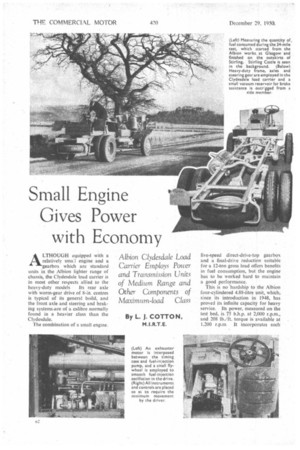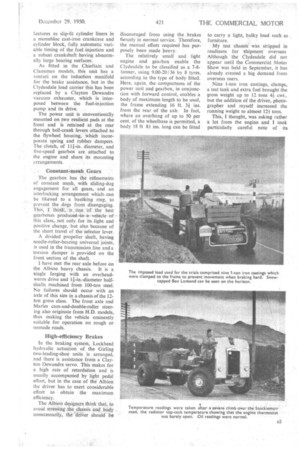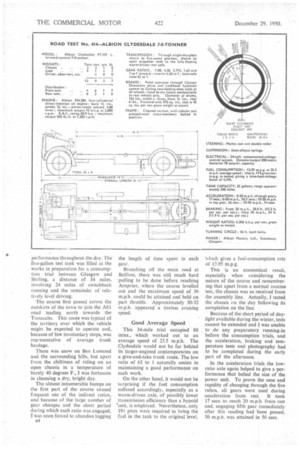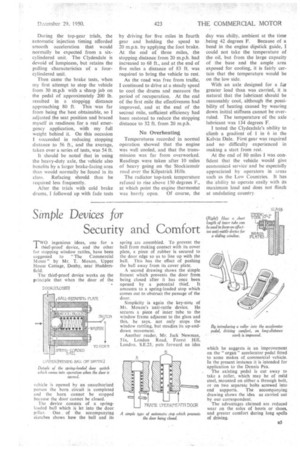Small Engine Gives Power with Economy
Page 36

Page 37

Page 38

Page 39

If you've noticed an error in this article please click here to report it so we can fix it.
A ibion Clydesdale Load Carrier Employs Power and Transmission Units of Medium Range and Other Components of Maximum-load Class By L. J. COTTON,
M.I.R.T.E.
ALTHOUGH equipped with a relatively sma:i engine and a gearbox which are standard units in the Albion lighter range of chassis, the Clydesdale load carrier is in most other respects allied to the
heavy-duty models Its rear axle with worm-gear drive of 8-in. centres is typical of its general build, and the front axle and steering and braking systems are of a calibre normally found in a heavier class than the Clydesdale.
The combination of a small engine. five-speed direct-drive-lop gearbox and a final-drive reduction suitable for a 12-ton gross load offers benefits in fuel consumption, but the engine has to be worked hard to maintain a good performance.
This is no 'hardship to the Albion four-cylindered 4,88-litre unit, which, since its introduction in 1948, has proved its infinite capacity for heavy service. Its power, measured on the test bed, is 75 la,h.p. at 2,000 r.p.m., and 208 lb./ft. torque is available at 1,200 r.p.m It incorporates such features as slip-fit cylinder liners in a monobloc cast-iron crankcase and cylinder block, fully automatic variable timing of the fuel injection and a robust crankshaft having abnormally large bearing surfaces.
As fitted in the Chieftain and Clansman models, this unit has a ventttri on the induction manifold for the brake assistance, but in the Clydesdale load carrier this has been replaced by a Clayton Dewandre vacuum exhauster, which is interposed between the fuel-injection pump and its drive.
The power unit is conventionally mounted on two resilient pads at the front and is retained at the rear through bell-crank levers attached to the flywheel housing, which incorporate spring and rubber dampers. The dutch, of 111--in. diameter, and five-speed gearbox are attached to the engine and share its mounting arrangements.
Constant-mesh Gears
The gearbox has the refinements of constant mesh, with sliding-dog engagement for all gears, and an interlocking arrangement whichcan be likened to a baulking ring, to prevent the dogs from disengaging. This, .1 thirik;.•is .One of the best gearboxes produced-Au --a vehicle of this class,. not only for its _light and positive change, hut also because of the short travel of the selector lever.
A divided propeller shaft, having needle-roller-bearing universal joints, is used in the transmission line and a torsion damper is provided on the front section of the shaft.
I have met the rear axle before on the Albion heavy chassis. It is a single forging with an overheadworm drive and li-in.-diameter halfshafts machined from 100-ton steel. No failures should occur with an axle of this size in a chassis of the 12ton gross class. The front axle and Marks cam-and-double-roller steering also originate from H.D. models, thus making the vehicle eminently suitable for operation on rough or unmade roads.
High-efficiency Brakes
In the braking system, Lockheed hydraulic actuation of the Girling two-leading-shoe units is arranged, and there is assistance from a Clayton Dewandre servo. This makes for a high rate of retardation and is usually accompanied by light pedal effort, but in the case of the Albion the driver has to exert considerable effort to obtain the maximum efficiency.
The Albion dv;signers think that, to avoid stresiing the chassis and body unnecessarily, the driVer should be
discouraged from using the brakes fiercely in normal service. Therefore, the manual effort required has purposely been made heavy.
The relatively small and light engine and gearbox enable the Clydesdale to be classified as a 7-8tonner, using 9.00-20/36 by 8 tyres, according to the type of body fitted. Here, again, the compactness of the power unit and gearbox, in conjunction with forward control, enables a body of maximum length to be used, the frame extending 16 ft. 31 ins. from the rear of the cab. In fact, where an overhang of up to 50 per cent. of the wheelbase is permitted, a body 18 ft 8i ins, long can be fitted
to carry a light, bulky load such as furniture.
My test chassis was stripped in readiness for shipment overseas Although the Clydesdale did not appear until the Commercial Motor Show was held in September, it has already created a big demand from overseas users.
Nine 1-ton iron castings, clamps, a test tank and extra fuel brought the gross weight up to 12 tons 4i cwt., but the addition of the driver, photographer and myself increased the running weight to almost 12i tons.
This, I thought, was asking rather a lot from the engine and I took particularly careful note of its
performance throughout the day. The five-gallon test tank was tilled at the works in preparation for a consumption trial between Glasgow and Stirling, a distance of 34 miles. involving 24 miles of switchback running and the remainder of relatively level driving.
The course first passed across the outskirts of the town to join the A81 road leading north towards the Trossachs. This route was typical of the territory over which the vehicle might be expected to operate and, because of few involuntary stops, was representative of average trunk haulage.
There was snow on Ben Lomond and the surrounding hills, but apart from the chilliness of riding on an open chassis in a temperature of barely 40 degrees F., I was fortunate in choosing a dry, bright day.
The almost innumerable humps on the first part of the course caused frequent use of the indirect ratios, and because of the large number of gear changes and the short period during which each ratio was engaged, I was soon forced to abandon logging 84 the length of time spent in each gear.
Branching off the main road at Balfron, there was still much hard pulling to be done before reaching Arnprior, where the course levelled Out and the maximum spced of 36 m.p.h. could be attained and held on part throttle. Approximately 30-32 m.p.h. appeared a tireless cruising speed.
Good Average Speed
This 34-mile trial occupied 80 mins., which worked out to an average speed of 25.5 m.p.h. The Clydesdale would not be far behind its larger-engined contemporaries on a give-and-take trunk route. The low ratio of 6.1 to 1 naturally assists in maintaining a good performance on such work.
On the other hand, it would not be surprising if the fuel consumption sullered accordingly, especially as a worm-driven axle, of possibly lower transmission efficiency than a hypoid 'unit, is employed. Nevertheless, only 19:;. pints were required to bring the fuel in the tank to the original level, ‘vhich gives a fuel-consumption rate of 13.95 m.p.g.
This is an economical result, especially when considering the nature of the course and remembering that apart from a normal routine test, the chassis was as received from the assembly line. Actually, I tested, the chassis on the day following its completion on the line.
Because of the short period of daylight available during the winter, tests cannot be extended and I was unable to do any preparatory running-in before the consumption trials, and the acceleration, braking and temperature tests and photography had to be completed during the early part of the afternoon.
In the acceleration trials the lowratio axle again helped to give a performance that belied the size of the power unit. To prove the ease and rapidity of changing through the five ratios, all gears were used during acceleration from rest. It took 17 secs. to reach 20 m.p.h. from rest and, engaging fifth gear immediately after this reading had been passed, 30 m.pin. was attained in 50 secs. During the top-gear trials, the automatic injection timing afforded smooth acceleration that would normally be expected from a sixcylindered unit. The Clydesdale is devoid of lumpiness, but retains the pulling characteristics of a fourcylindered unit.
Then came the brake tests, when my first attempt to stop the vehicle from 30 m.p.h with a sharp jab on the pedal of approximately 200 lb. resulted in a stoppiog distance approaching 80 ft. This •was far from being the best obtainable, so adjusted the seat position and braced myself in readiness for a real emergency application, with my full weight behind it. On this occasion 1 succeeded in reducing stopping distance to 56 ft., and the average, taken over a series of tests, was 54 ft.
It should be noted that in using the heavy-duty axle, the vehicle also benefits by a larger brake-facing area than would normally be found in its class. Refacing should thus be required less frequently.
After the trials with cold brake drums, I followed up with fade tests by driving for five miles in fourth gear and holding the speed to 20 m.p.h. by applying the foot brake. At the end of three miles, the stopping distance from 20 m.p.h. had increased to 68 ft., and at the end of five miles a distance of 83 ft. was required to bring the vehicle to rest.
As the road was free from traffic, I continued to drive at a steady speed to cool the drums and measure the period of recuperation. At the end of the first mile the effectiveness had improved, and at the end of the second mile, sufficient efficiency had been restored to reduce the stopping distance to 32 ft. from 20 m.p.h.
No. Overheating Temperatures recorded in normal operation showed that the engine was well cooled, and that the transmission was far from overworked. Readings were taken after 10 miles of heavy going on the Stockiemuir road over the Kilpatrick Hills.
The radiator top-tank temperature refused to rise above 150 degrees F., at which point the engine thermostat was barely open. Of course, the
day was chilly, ambient at the time being 42 degrees F. Because of a bend in the engine dipstick guide, I could not take the temperature of the oil, but from the large capacity of the base and the ample area exposed for cooling, it is fairly certain that the temperature would be on the low side.
With an axle designed for a far greater load than was carried, it is natural that the lubricant should be reasonably cool, although the possibility of heating caused by wearing down initial stiffness cannot be overruled. The temperature of the axle lubricant was 134 degrees F.
I tested the Clydesdale's ability to climb a gradient of 1 in 6 in the Kelvin Dale. First gear was required and no difficulty experienced in making a start from rest.
At the end of 80 miles 1 was confident that the vehicle would give economical service and be especially appreciated by operators in areas such as the Low Countries. It has the ability to operate easily with its maximum load and does not flinch at undulating country.




















































































